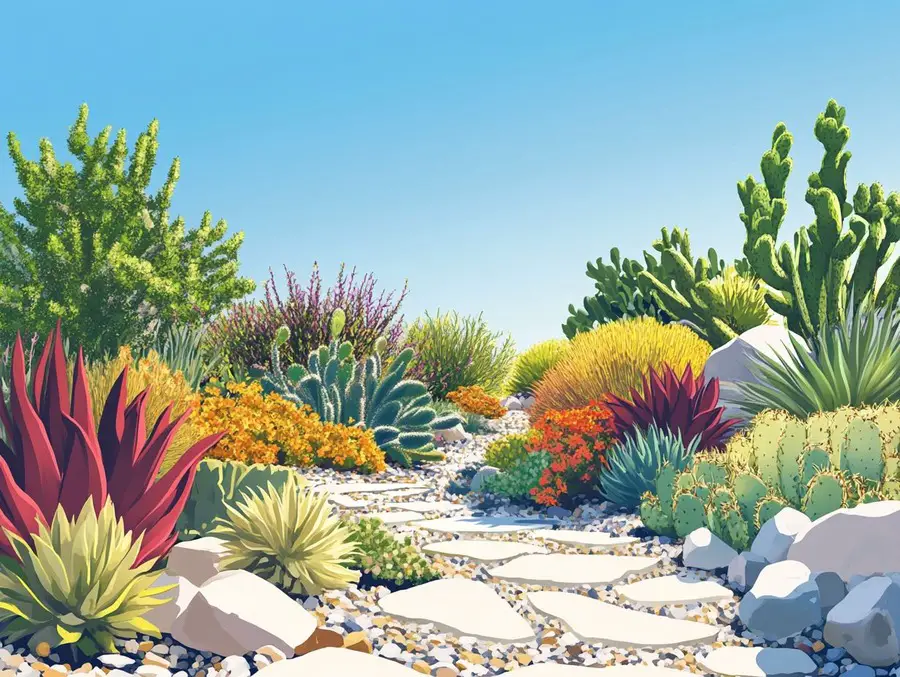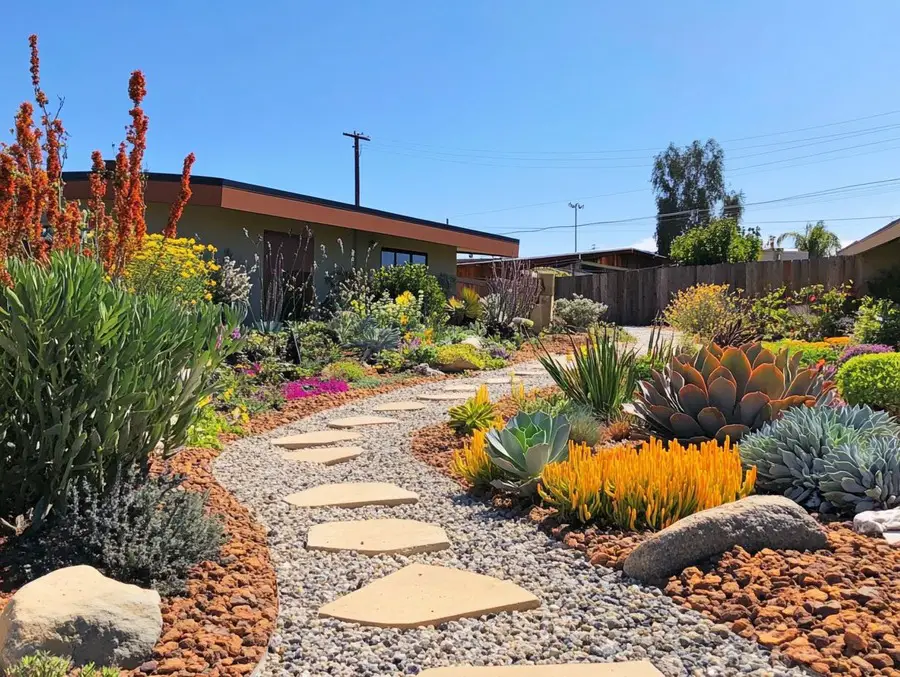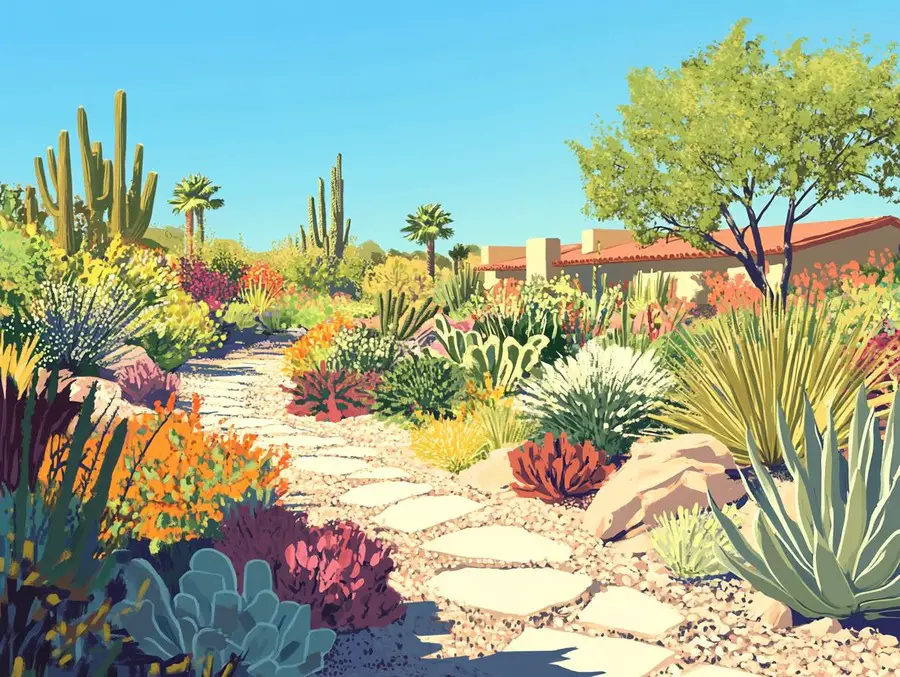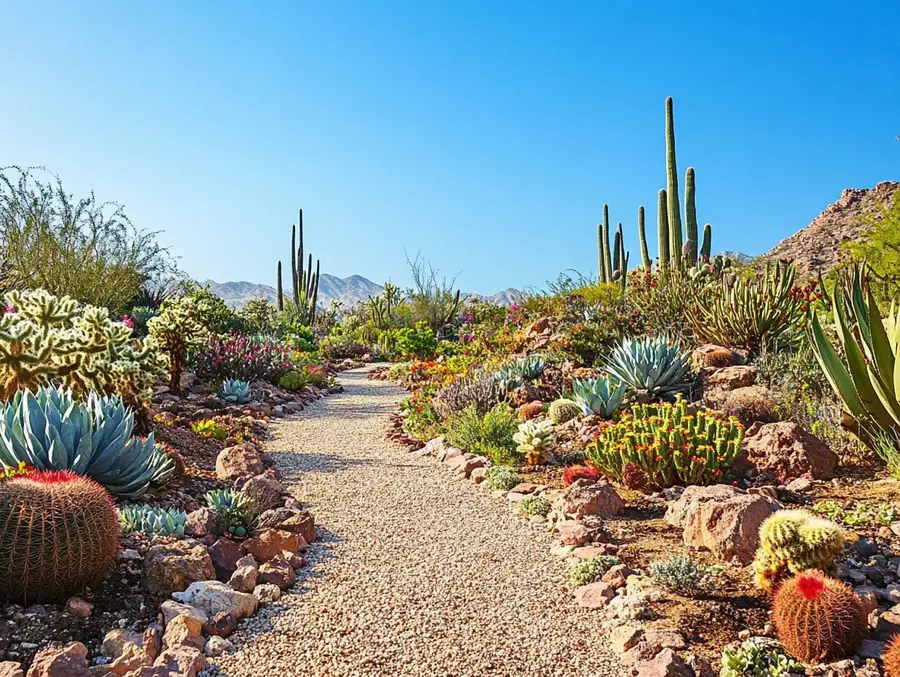
What is xeriscaping? It’s a smart landscaping approach designed to save water, cut maintenance, and boost your garden’s beauty.
Tired of high water bills and constant yard work?
Xeriscaping offers a sustainable solution that’s simple to implement and perfect for creating vibrant, eco-friendly outdoor spaces. Let’s explore how it works!
What is Xeriscaping? Key Takeaways
- Xeriscaping is a water-saving landscaping method that uses drought-resistant plants and efficient irrigation systems.
- It reduces water consumption, lowers maintenance needs, and supports biodiversity.
- Perfect for dry climates, it creates eco-friendly outdoor spaces that thrive with minimal resources while conserving precious natural water supplies.
What is Xeriscaping? Save Water, Time, and Money
In a world that’s increasingly grappling with water scarcity and environmental issues, xeriscaping is stepping in as a sustainable gardening hero.
This approach lets you create stunning landscapes that conserve water while keeping your maintenance chores to a minimum.
Dive into the many perks of xeriscaping, like its environmental benefits and financial savings.
You’ll learn how to design your own xeriscape garden, pick the right drought-tolerant plants, and keep your outdoor space thriving.
Plus, you’ll find tips on making the switch from traditional gardening methods to a more sustainable xeriscape.
Embrace the charm of water-wise gardening and see how it can brighten up your home and benefit the planet.
What is Xeriscaping and Why is it Important?

Xeriscaping is a smart landscaping approach that focuses on conserving water by using drought-resistant plants and efficient irrigation systems.
This method is especially crucial in arid climates where water resources are limited, helping to maintain a healthy ecosystem and reduce your environmental impact.
By embracing xeriscaping principles, you can transform your outdoor space into a lush and vibrant area filled with native plants that promote biodiversity, all while using less water.
Benefits of Xeriscaping
You’ll find that the benefits of xeriscaping are pretty impressive, from saving a ton of water to boosting the overall look of your outdoor spaces.
By embracing water-efficient gardening practices, you lower your environmental footprint and help create a sustainable landscape that stays resilient and beautiful even when the weather gets tough.
Environmental and Financial Benefits
Xeriscaping is a game-changer for both your wallet and the environment, making it a smart choice for you and your community.
By using water-saving techniques and picking drought-resistant plants, you can cut down on those pesky water bills while also doing a solid for the ecological health of your area.
When you implement xeriscaping, you’ll notice a drop in water usage since native plants usually need less irrigation.
This means you’re conserving precious resources. Plus, this landscaping approach helps reduce soil erosion by encouraging deep-rooted plants that stabilize the earth, which is great for keeping local waterways clean.
Another cool perk is improved biodiversity. A mix of plants creates cozy habitats for local wildlife, which boosts the ecosystem.
On the financial side, you’ll likely see lower maintenance costs because xeriscaped gardens are pretty resilient.
With minimal upkeep, your landscape can thrive, and that attractive, sustainable look can actually increase your property value.
So, xeriscaping is definitely a win-win investment!
Designing a Xeriscape Garden
Designing your xeriscape garden requires some careful planning and a bit of thought about your landscape elements.
You want to make sure your outdoor space is beautiful and eco-friendly.
By incorporating principles of sustainable gardening and smart landscaping design, you can create a functional garden that thrives with minimal water and maintenance.
Plus, it’ll really boost the overall aesthetics of your property!
Factors to Consider and Tips for Success

When you’re designing your xeriscape garden, there are a few key factors you’ll want to keep in mind, like the garden layout, plant selection, and the right irrigation systems.
By implementing a solid landscaping strategy, you can create a garden that conserves water and thrives in its unique environment, showcasing the principles of sustainable gardening.
To hit those goals, it’s important to first get a handle on the soil types in your area.
Knowing your soil will help you choose the best drought-resistant plants that can flourish with minimal watering.
Creating microclimates within your garden can really boost plant health.
By providing sheltered areas, you’ll protect against harsh environmental conditions.
Using efficient irrigation techniques, like drip systems, will make sure water goes exactly where it’s needed while keeping evaporation to a minimum.
And don’t forget about regular maintenance!
Strategic pruning and mulching will make your xeriscape garden look great and promote the overall vitality of your plants, ensuring your sustainable oasis is both functional and visually appealing.
Plants for Xeriscaping
Choosing the right plants for your xeriscape garden is key to creating a water-efficient and visually stunning landscape.
When you opt for drought-tolerant and native plants, you’ll boost the biodiversity of your outdoor space, promote ecological balance, and cut down on water usage.
This approach will help you cultivate a thriving xeric garden that looks great and uses resources wisely.
Choosing Drought-Tolerant and Native Plants
Choosing the right drought-tolerant and native plants is crucial for keeping your xeriscaping project thriving.
By focusing on xerophytes and other resilient species, you can make sure your garden stays vibrant and healthy while adapting to local climate conditions and saving water.
When you’re picking the best plants for your xeriscaping efforts, take a look at their hardiness zones.
These zones will tell you how well they’ll do in your specific climate.
It’s also helpful to evaluate their growth habits, whether they spread out as ground cover or stand tall.
This can help you create a structure and visual appeal in your garden that you’ll love.
Don’t forget about adaptability! Some plants can flourish in poor soil or handle extreme temperatures while still offering seasonal interest with their flowers, variegated foliage, or unique textures.
With so many options out there, ranging from low-growing ground covers to stunning perennials, you have plenty of opportunities to design a landscape that’s beautiful, sustainable, and easy to maintain.
Maintenance of Xeriscapes
Keeping your xeriscape in top shape is key to ensuring your garden stays healthy and lasts a long time.
By getting a grasp on effective irrigation practices, managing soil moisture, and using water-saving techniques, you can create a thriving xeriscape that doesn’t demand a ton of effort or resources.
Efficient Watering and Other Maintenance Practices

Efficient watering practices are key to keeping your xeriscape garden healthy and sustainable.
By using effective irrigation systems and managing soil moisture, you can boost your garden’s productivity while making sure your plants thrive without drowning them in water.
There are several great watering methods to consider, like drip irrigation and rainwater harvesting.
- Drip irrigation sends water straight to the roots of your plants, which helps cut down on evaporation and runoff.
- On the other hand, rainwater harvesting makes the most of natural rain, adding an extra layer of sustainability to your gardening efforts.
Regular maintenance is also crucial—check for clogs in your drip lines and make sure your rainwater storage is in good shape.
And don’t forget about seasonal plant care!
Adjusting your watering schedule based on climate changes and keeping an eye on soil moisture levels will help ensure your xeriscape garden stays vibrant all year round.
Transitioning to Xeriscaping
Transitioning from traditional gardens to xeriscaping might feel a bit overwhelming at first, but with the right approach and techniques, you can create a sustainable and eco-friendly landscape that thrives in dry conditions.
By incorporating xeriscaping principles and strategies, you can revitalize your outdoor space, boost the garden’s ecology, and do your part for water conservation.
Converting Traditional Gardens to Xeriscapes
Converting your traditional garden to a xeriscape is all about careful planning and a smart approach to garden design.
By making thoughtful choices about irrigation, plant selection, and xeriscaping materials, you can turn your outdoor space into a sustainable, water-efficient oasis.
Start by assessing what you already have in your garden. Take a good look at the soil type, sunlight exposure, and existing plants.
Once you have that down, think about selecting drought-resistant plants that fit your local climate. This way, they’ll thrive with minimal water needs.
Next up, consider implementing water-saving irrigation methods, like drip systems or soaker hoses.
These methods are great for delivering moisture right to the roots, making your watering much more efficient.
Over time, you might even want to swap out traditional grass for native ground covers.
This cuts down on water usage, but it’ll also help promote local biodiversity.
These practical strategies will save water and create a vibrant landscape that thrives, even in dry conditions.
Frequently Asked Questions
What is Xeriscaping?
Xeriscaping is a landscaping method that focuses on using low-water and drought-resistant plants to create a sustainable and environmentally friendly outdoor space.
How does Xeriscaping benefit the environment?
Xeriscaping helps conserve water by using plants that are naturally suited to the climate, reducing the need for irrigation.
This also reduces the use of pesticides and fertilizers, which can harm the environment.
What are some examples of plants used in Xeriscaping?
Some common plants used in Xeriscaping include succulents, cacti, and other drought-resistant plants such as lavender, sage, and rosemary.
Do I have to completely remove my lawn for Xeriscaping?
No, Xeriscaping does not require the removal of all lawn areas.
However, it does encourage the use of native grasses and ground covers that require less water and maintenance.
Is Xeriscaping only suitable for dry climates?
While Xeriscaping is most commonly associated with dry and arid regions, it can also be used in other climates by incorporating elements such as rainwater harvesting and soil amendments.
What are the benefits of Xeriscaping for homeowners?
Plus, being environmentally friendly, Xeriscaping can also save homeowners time and money by reducing the need for constant watering, mowing, and maintenance of traditional lawns.
Xeriscaping for Beginners: Easy Water-Saving Yard Tips
What is xeriscaping? A beginner’s guide to drought-tolerant landscaping
